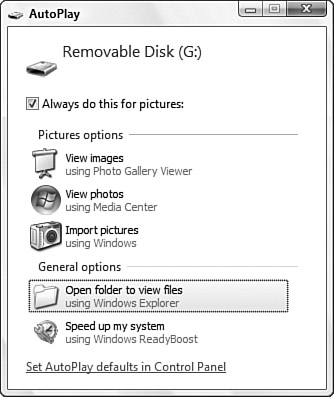The AutoPlay feature dictates the program that runs
automatically when you insert removable media into a slot in the
computer. We’ve had AutoPlay for CDs since Windows 95, and Windows XP
added AutoPlay support for most types of removable media, including
DVDs, flash drives, and memory cards.
AutoPlay has become more sophisticated over the
years, to the point that XP offered several choices when you inserted
removable media, and those choices depended on the contents of the
media. For music files, for example, AutoPlay could play or rip the
files in Windows Media Player or just open a folder window to view the
files. For pictures, AutoPlay could launch the Scanner and Camera
Wizard, start a slideshow, launch the Photo Printing Wizard, or view the
images. In addition, many third-party programs could tie into the
AutoPlay feature and add their own actions to the AutoPlay menu (for
example, to play music files in a different program or to edit pictures
in an image-editing program).
However, customizing AutoPlay has never been
easy. You could always choose a default action when the AutoPlay window
appeared, but what if you wanted to change the default? In XP, you
configured AutoPlay by opening the property sheet for a drive and then
displaying the AutoPlay tab. You then used a drop-down list to choose
the content type, clicked the default action, and then clicked Apply.
From there you had to repeat this procedure for all the different
content types: music files, pictures, video files, mixed content, music
CD, DVD movie, and blank CD. Finally, you had to run through all of
these steps for all the other removable drives on your system. No doubt
sensing that users had better things to do, Microsoft has greatly
streamlined the customization of AutoPlay defaults in Windows Vista.
Before getting to the customization feature, I should point out that
Windows Vista also implements an improved AutoPlay window. Figure 1
shows an example. As you can see, Vista’s AutoPlay window divides the
options into two sections: The top section contains actions specific to
the dominant content type on the media, and the bottom section—General
Options—contains actions not related to content.

To customize the AutoPlay defaults, you have two choices:
If the AutoPlay window is onscreen, click the Set AutoPlay Defaults in Control Panel link.
Select Start, Control Panel, Hardware and Sound, AutoPlay (or just launch the AutoPlay icon if you’re using Classic view).
Either way, you end up at the AutoPlay window shown in Figure 2.
This page lists 16 different content types, from Audio CD to Super
Video CD, and even HD DVD and Bluray. Each content type has its own
drop-down list, and you use that list to select the default action for
each type.